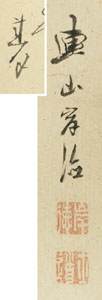Kishi
Momiji - Autumn leavesSigned: Renzan Gan Toku, Rengetsu
Seals: Gantoku Shidô
Technique: sumi and red on paper 97.4 x 29.7
Mounting: blue brocade and yellowish crushed paper 172.5 x 32.3
Condition: good
大空に たが手向つる ぬさならん かぜも紅葉の いろになるまで
Oozora ni
ta ga tamuke tsuru
nusa nara n
kaze mo momiji no
iro ni naru made.
Making an offering
of sacred white paper
to the Great Sky―
may the wind dye it
the color of crimson leaves. (Rengetsu #153)
For more than ten years Renzan was a pupil of Gan Ku (1749-1838). When he married Gan Ku’s daughter he was adopted into the Kishi family. Like his father-in-law he was in the service of Arisugawa-no-Miya.
Renzan absorbed many elements of the Shijô so his work differs considerably from that of Ganku. After Gan Ku’s death, Renzan and Gan Tai (1782-1865) became the leaders of the Kishi school.
Reference:
Ritto 1996 p. 49 ff. (# 33-38)
Roberts p. 129
Araki p. 923
Kyoto '98 p. 277 (# 3-11, 4-2, 13, 18, 20, 5-21)
Hillier' 74 p. 228 (# 169-171)
Rengetsu was born In Kyoto and within a few days after her birth adopted by the Ôtagaki family. In 1798 she moved to Kameoka castle to serve the Matsudaira family. Here she met with the woman pursuits as poetry and calligraphy, but received in training in martial arts as well. In 1807 she returned to her family in Kyoto where she married her adopted brother a young samurai called Mochihisa. In the 8 years of her marriage she gave birth to e children who all died shortly after their birth. In 1815 she divorced her husband who would shortly die. She remarried but already in 1823 her second husband died. She cut her hair and became a nun and took the name Rengetsu, Lotus moon.
With her daughter from her second marriage and stepfather she moved into a small building on the grounds of the Chion-in. Two years later her daughter died. She started composing waka poetry, but without means for support she moved to Okazaki in the area of Kyoto to produce pottery, studied waka intensively and studied Shijô painting with Matsumura Keibun (1779-1843) fell in love with him and lived together. In Okazaki a place with many artists she intensively trained to study waka. Although being a nun men approached her with advances, but not being interested, she pulled out her teeth to look less attractive and to strengthen her inner self Her pottery became such a big success that she escaped her customers many times and moved more than 30 times in one year even 13 times.
She became friends with Tomioka Tessai (1836-1924) and even tried to adopt him as a son. For the last 25 years of her life he helped and accompanied her. On the invitation of the Abbot Wada Gesshin (Gozan) (1800-1870) she spent her last 10 years of her life in a tea hut the Jinko-in temple and deeply immersed herself in the study of Buddhism and but also continued her artistic occupations.
Reference:
Kyoto 2014
Canberra 2007
Kodansha 1971
Fister '88 pp. 144-159 (# 69-76)
Roberts p. 129
Price: SOLD

